La correcta elección del sistema de filtración para estanques constituye el núcleo clave para unas prácticas óptimas en la gestión de piscinas naturalizadas. De hecho, seleccionar el tipo adecuado de medio filtrante para estanques tiene un impacto significativo no solo en la calidad del agua, sino que afecta en cascada a una serie de aspectos importantes para los operadores, desde las necesidades de mantenimiento a largo plazo hasta los costes operativos y la experiencia de los bañistas.
Las piscinas naturales empezaron a estar de moda a principios de los 80 en los complejos turísticos alpinos, que intentaban imitar los lagos de montaña, permitiendo a los huéspedes la experiencia de nadar en una piscina de montaña con la comodidad de las instalaciones de agua artificial. Desde entonces, las piscinas naturales han experimentado un cierto renacimiento, impulsado por las tendencias actuales de diseño de lagunas y el nuevo movimiento de hostelería sostenible.
Con el creciente interés por las piscinas naturales, también han surgido preguntas sobre cómo elegir el sistema de filtración de estanques adecuado para garantizar que las piscinas no sólo sean pintorescas, sino que también ofrezcan un agua limpia y segura para bañistas e invitados. Profundicemos en los sistemas de filtración para estanques para descubrir las opciones clave, incluidos los medios filtrantes, la mecánica y las soluciones de tratamiento.
Sumérgete más con nuestro Ebook
How does a pond filtration system work?
However picturesque a pool may be, swimmers need to be able to swim in clean, safe water. This is why the design of pond filtration systems lies at the heart of the best practices in swimming pond design, through their role in improving water quality and maintaining water values such as pH, KH and phosphate, among others.
The very concept of swimming ponds implies an emphasis on the natural, so that pond filtration systems must adjust to this concept. As such, these are water features that use natural filtration and treatment substances, where water quality is under control continuously, while also ensuring the experience remains as natural as possible.
This translates into a variety of pond filtration system approaches, available in a continuum from the purely natural (that embraces authentic natural swimming) to the ones that incorporate additional mechanisms (from mechanical filtration to low salt hydrolysis filtration systems) to ensure crystal clear water at all times.
In this continuum, the following are the two basic components on which water pond filtration systems rely on:
- The regeneration zone: a planted area responsible for water purification, where carefully selected aquatic plants filter water naturally. In their earliest iterations and today’s most natural options, water is solely filtered via a large area of vegetation. Plant selection should be based on local climate and water chemistry, while also functional, with a selection of oxygenators, floating plants and marginal plants. The size and location of this regeneration area is key: it should receive the required sunlight exposure to support plant growth, while also taking advantage of air currents for water circulation. Additionally, it should be designed with factors such as the desired swimming area, bather load, climate, and water source in mind.
- Filtration and water treatment equipment: mechanical, treatment and filter media options are available. The circulation and filtration system is key, and consists of skimmers to clear debris, pumps that circulate water and biological filtration components, which can include gravel beds and plantation zones.
What is the best pond filter system? Types of pond filter media and their characteristics
In broad terms, the best pond filtration system is the one that ensures water quality and safety while also guaranteeing efficiency in doing so.
As such, it should be able to:
- Remove solid waste and debris.
- Break down harmful compounds to ensure safe water chemistry.
- Support a stable ecosystem that, ultimately, is a self-regulating, low-maintenance environment.
- Operate efficiently, minimizing energy consumption needs while also guaranteeing low maintenance requirements.
Below, we gather some of the most innovative approaches to pond filtration systems, bringing pond water quality to the next level while offering diverse options for natural swimming experiences.
As such, the cutting-edge alternatives outlined below go from 100% pure natural pool options, to choices where filtration and water treatment systems take a more active role:
Pure Nature
The Pure Nature model features a wealth of flora and fauna, which along with a small waterfall or fountain, serve to keep the water clean. The result is a rich natural environment full of color.
In this model and just like it happens in nature, periodic cloudy water is normal, but with regular maintenance (pruning the planting zones, vacuuming the bottom, etc.) the water will remain largely clear.
Since the walls of this type of pond are not free from algae and/or biofilm, the use of bacterial formulas is strongly recommended to improve water quality in general. This is especially the case in warmer climates, where algae grow more easily.
Therefore, it’s important to note that this option is for those who want their natural swimming experience to be fully authentic.
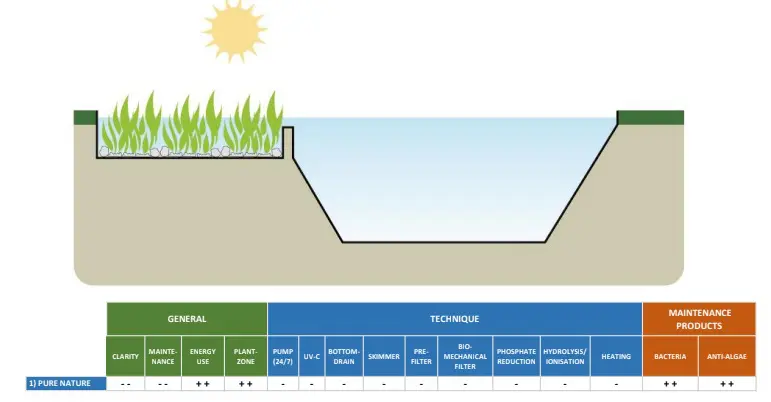
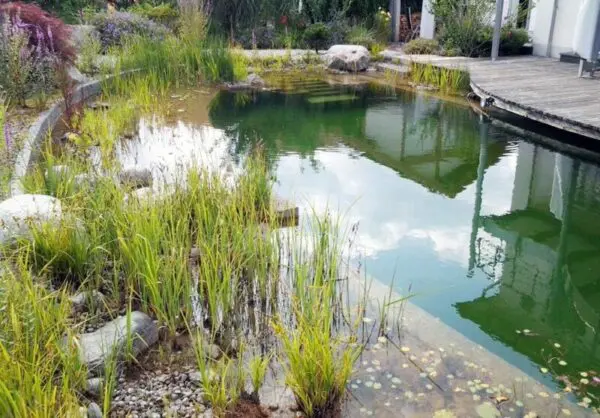
Natural
The Natural model is more or less the same as Pure Nature but with the addition of a low-power mechanical filter. Maintenance and power consumption are still reasonably light, using only skimmers, pond filter media, and UVC. There are three possible systems, described in the diagrams below:
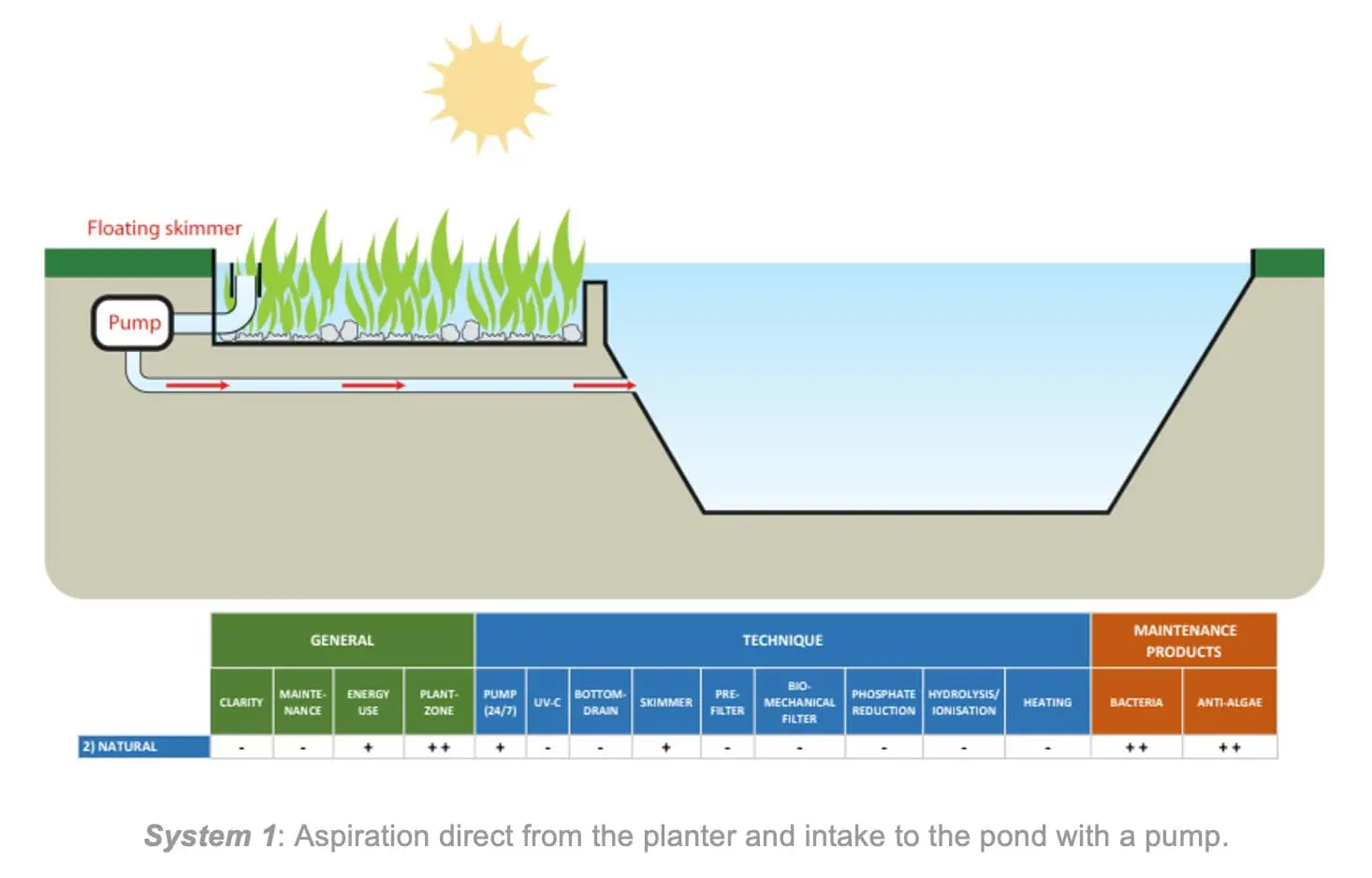
The use of these tools makes the water algae-free and relatively clear. UV is an essential tool to kill the floating green algae that’s particularly unappealing to swimmers. Technically, a well-built natural plant/substrate filter can control algae by removing its sustenance, but this damages plant life that’s crucial for maintaining water clarity.
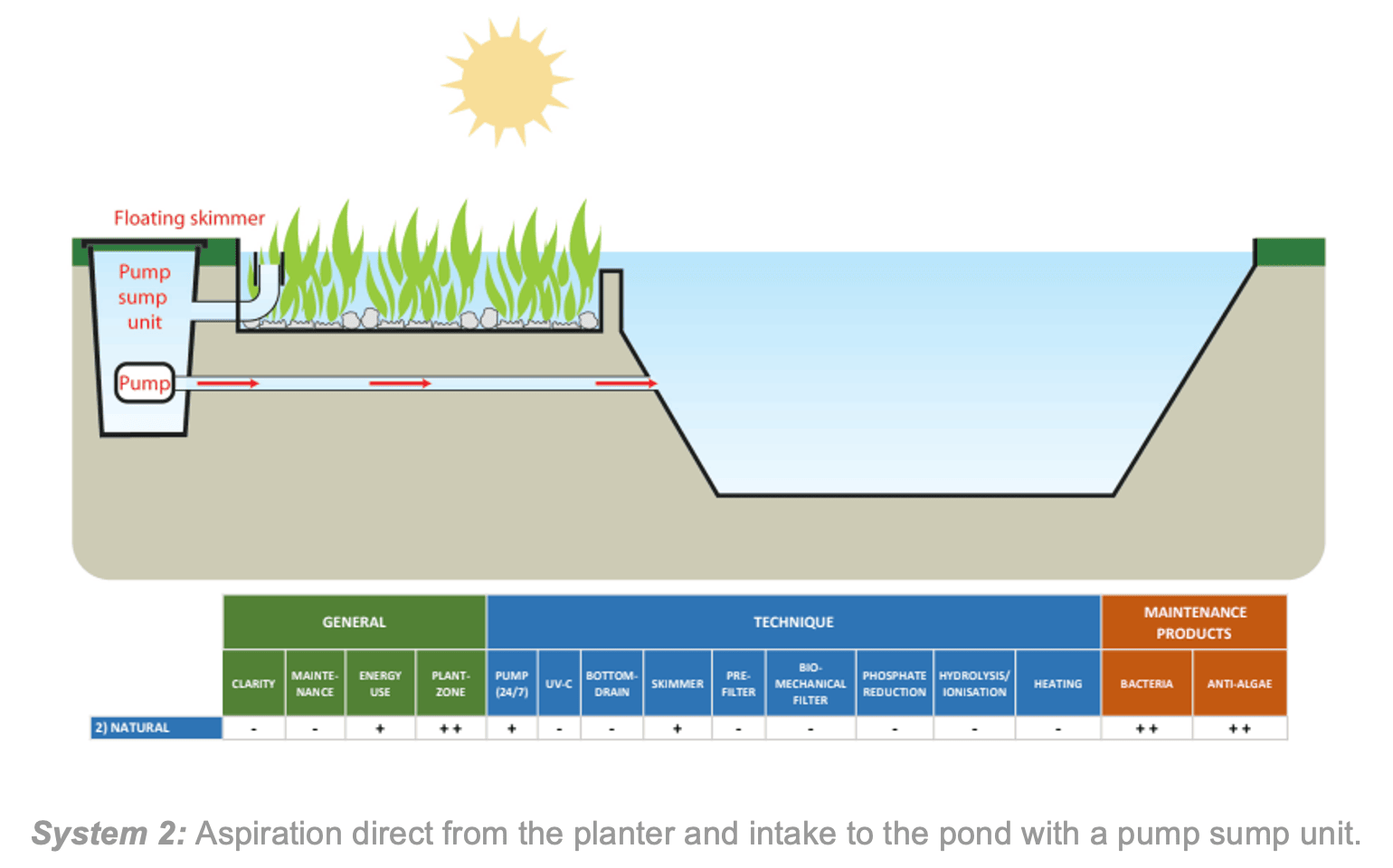
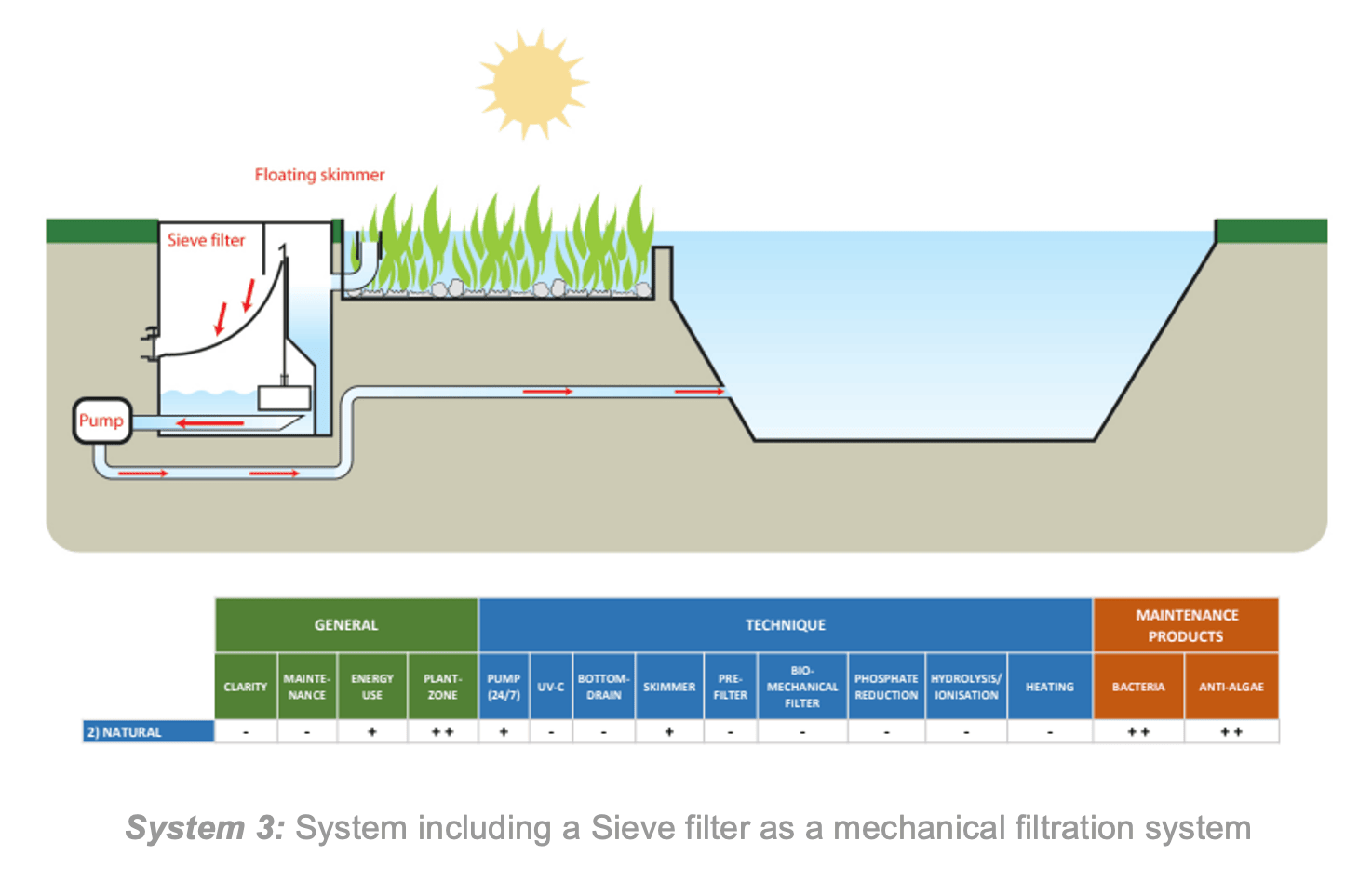
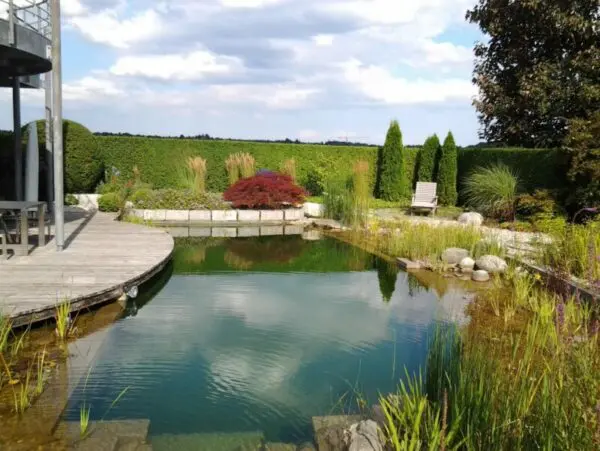
Clear
This type of swimming pond offers a natural experience where plant growth and diverse fauna are protagonists. However, thanks to the intervention of pond filter media and mechanics (described in the diagram) clear water is guaranteed all year round. While general maintenance is done periodically, backwashing filters must be cleaned regularly.

The most significant difference in the Clear model is the bead filter. The bead filter acts as a fine-mechanical filter: like a sand/cartridge filter, but with added benefits.
Conventional sand filters can block over time and are challenging to clear by backwashing. In a swimming pond, sand filters will work for a few months but then slowly start to block due to the biofilm that the naturally-occurring bacteria produce. This will clog the sand into big clumps that are difficult to remove by backwashing.
On the contrary, the bead filter is able to filter down to 5-10 microns without affecting backwashing capabilities after a few months of bacteria growth around the pond filter media. This offers a significant improvement from conventional sand filters, being the reason why it is thus integrated into the Clear models’ pond filtration systems.
The most significant difference in the Clear model is the bead filter. The bead filter acts as a fine-mechanical filter, like a sand/cartridge filter, but with added benefits. After a few months of bacteria growth around the pond filter system, it can filter down to 5-10 microns without affecting backwashing capabilities. This is a very important distinction between this media and sand filters, which can block over time and are challenging to clear by backwashing. In a swimming pond, sand filters will work for a few months but then slowly start to block due to the biofilm that the naturally-occurring bacteria produce. This will clog the sand into big clumps that are difficult to remove by backwashing.
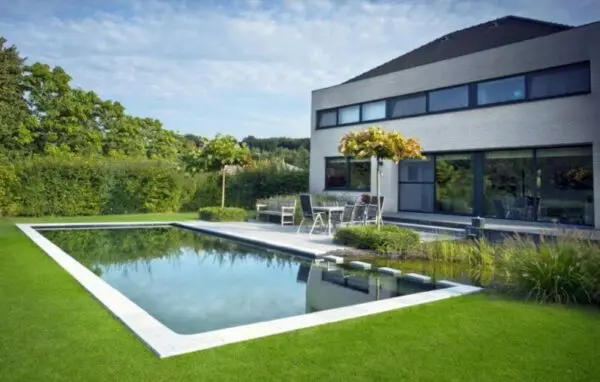
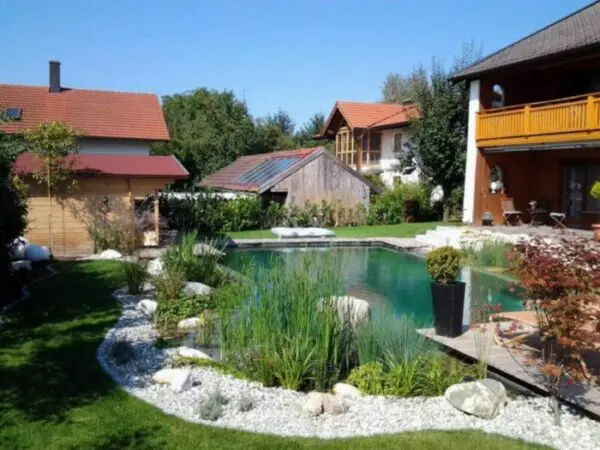
Crystal Clear
The Crystal Clear model guarantees clear water all year round, with limited flora and fauna. This pond filtration system relies on three core technologies:
- Low-energy pumps run 24/7 during the swimming season.
- A phosphate filtration system that deprives algae of sustenance.
- Phosfree (lanthanum chloride) released automatically with a Dosatech dosing pump, whose built-in timer ensures the same dose is delivered every day.
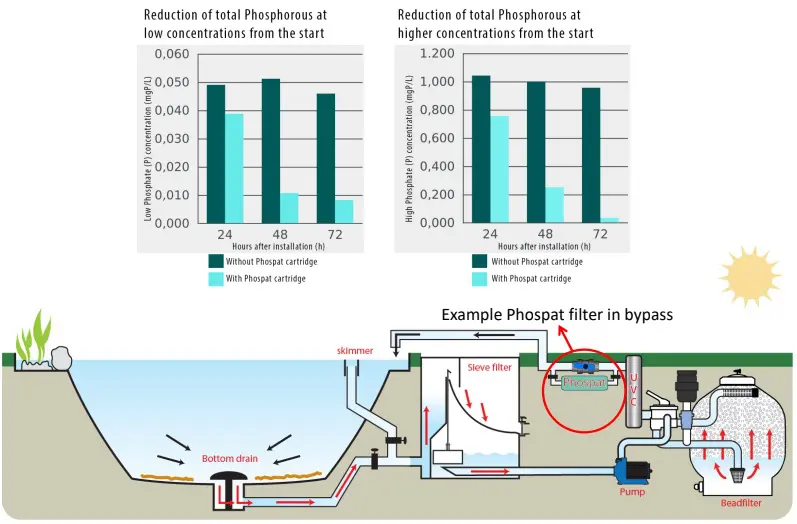
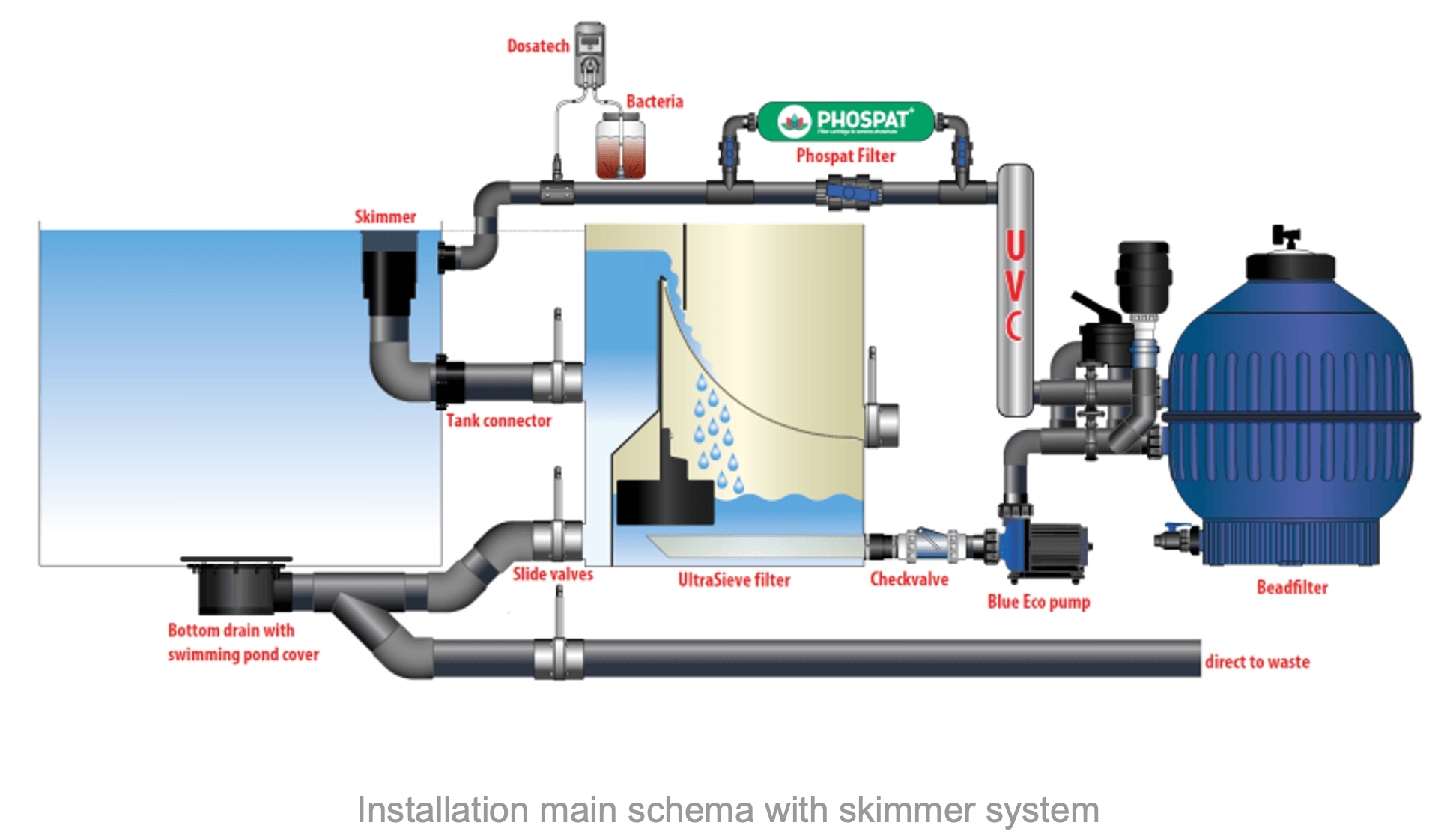
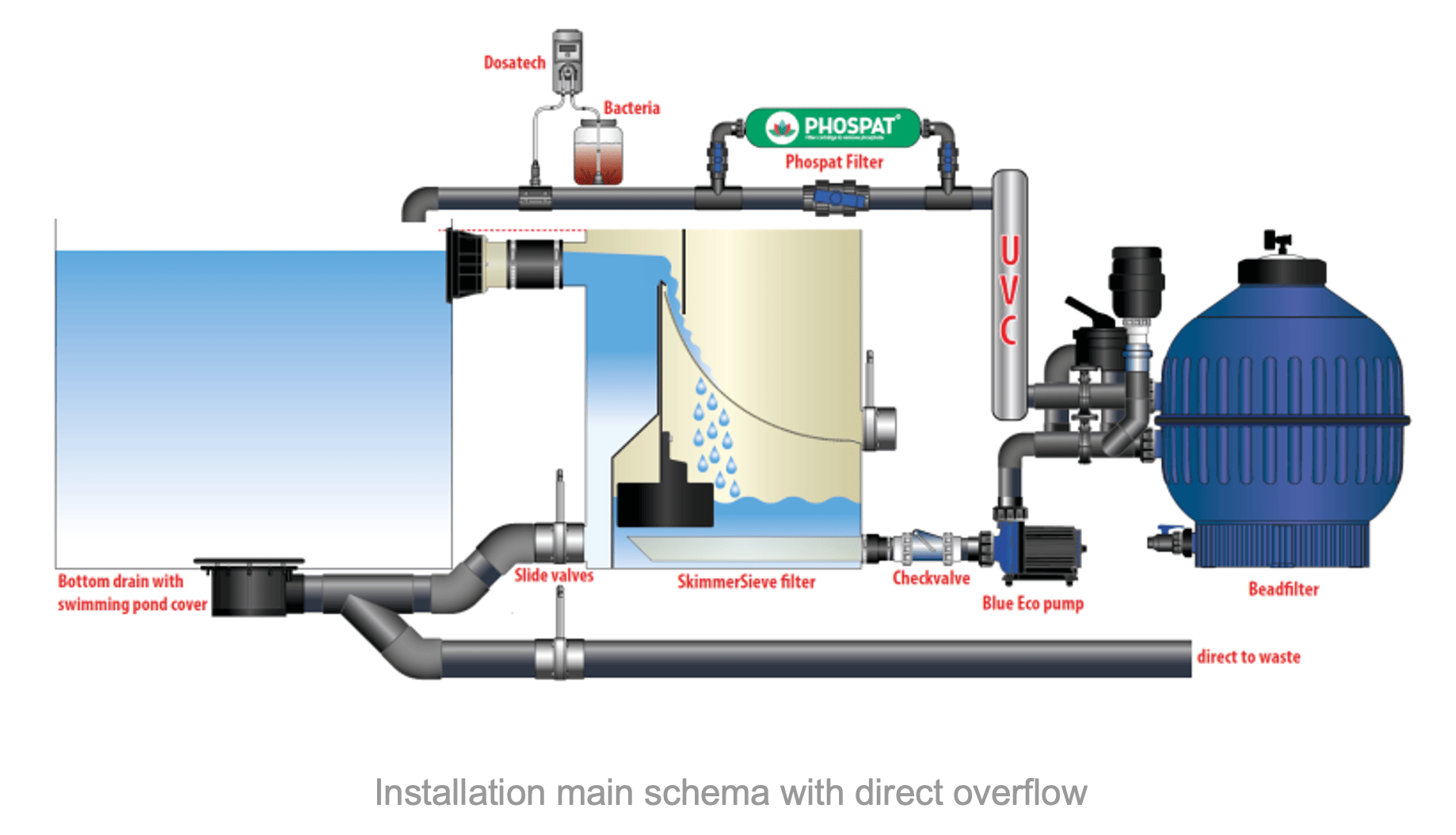
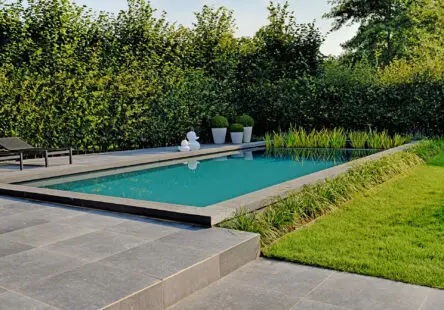
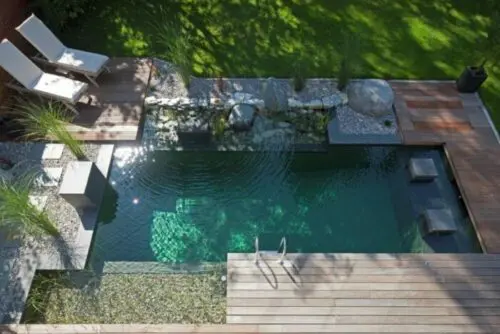
BioPool
Visually, the BioPool is a traditional swimming pool without plants, wildlife, or natural sides. The main difference is that the filtration and treatment system is chemical-free; instead, we use low salt hydrolysis systems to produce oxidants and a very, very low amount of chlorine, if necessary. By setting the redox value a lot lower than a standard pool (around 400mV instead of 700-750mV), the water has less chlorine than the average glass of European tap water.
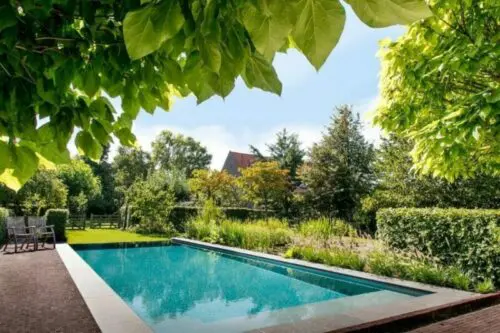
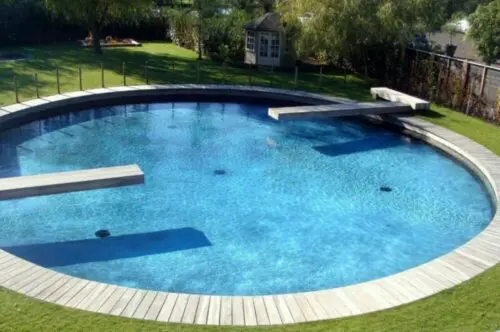
Pond Filter System: A version for every environment
Naturalized ponds and lakes emerge as an ideal solution for a wide variety of spaces: from hotels and resorts that incorporate natural pools to add substantial value to their offering by incorporating eco-friendly swimming facilities; to public spaces, residential communities and shopping centers.
These bodies of water can also enhance communal spaces, providing a natural, pleasant environment for guests. By generating a habitat that blends in perfectly with the surrounding environment, these aquatic spaces elevate both indoor and outdoor areas, while providing an exclusive feeling of swimming in a natural environment.
The natural pond filtration systems we’ve outlined above provide peace of mind when it comes to water safety and quality, all while reducing maintenance tasks.
When it comes to picking the right pond filtration system, each location and project requires personalized design and evaluation. Pool location as well as operators’ expectations will largely impact the type of pond filtration system that is needed. Additionally, relevant regulations for naturalized pools and ponds must also be taken into account, so that the project ensures compliance with the prescribed technical specifications.
No matter the location, natural pools enhance environments and provide a blueprint for fully sustainable pools with low maintenance needs.
